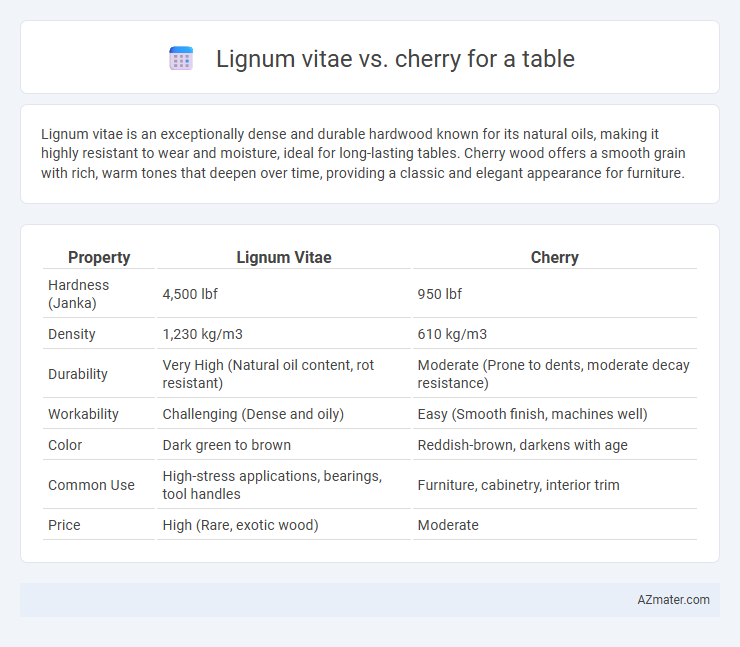Lignum vitae is an exceptionally dense and durable hardwood known for its natural oils, making it highly resistant to wear and moisture, ideal for long-lasting tables. Cherry wood offers a smooth grain with rich, warm tones that deepen over time, providing a classic and elegant appearance for furniture.
Table of Comparison
| Property | Lignum Vitae | Cherry |
|---|---|---|
| Hardness (Janka) | 4,500 lbf | 950 lbf |
| Density | 1,230 kg/m3 | 610 kg/m3 |
| Durability | Very High (Natural oil content, rot resistant) | Moderate (Prone to dents, moderate decay resistance) |
| Workability | Challenging (Dense and oily) | Easy (Smooth finish, machines well) |
| Color | Dark green to brown | Reddish-brown, darkens with age |
| Common Use | High-stress applications, bearings, tool handles | Furniture, cabinetry, interior trim |
| Price | High (Rare, exotic wood) | Moderate |
Introduction to Lignum Vitae and Cherry Wood
Lignum vitae is an exceptionally dense, oily hardwood known for its natural durability, resistance to wear, and rich greenish-brown color, making it ideal for heavy-use tables. Cherry wood offers a smooth texture with a warm reddish-brown hue that deepens over time, prized for its fine grain and ease of finishing in furniture making. Both woods provide unique aesthetic and functional qualities, with Lignum vitae favored for longevity and Cherry for its elegant appearance.
Botanical Origins and Species Overview
Lignum vitae, derived primarily from the species Guaiacum officinale and Guaiacum sanctum, is a dense, slow-growing hardwood native to the Caribbean and northern South America, known for its natural oils and exceptional durability. Cherry wood, mainly sourced from Prunus serotina, commonly referred to as black cherry, is native to North America and prized for its smooth grain, warm reddish hue, and relatively fast growth. Both species belong to distinct botanical families--Zygophyllaceae for Lignum vitae and Rosaceae for Cherry--offering unique aesthetic and structural qualities ideal for fine woodworking and table construction.
Visual Appearance and Color Differences
Lignum vitae features a dense, dark brown to olive-green hue with deep interlocking grain patterns, providing a rich and exotic appearance for tables. Cherry wood exhibits a warm, reddish-brown tone that deepens with age, showcasing a smooth, fine grain that enhances its classic and elegant look. The contrasting color palettes and grain textures between Lignum vitae and Cherry affect table aesthetics, with Lignum vitae offering a bold, dramatic visual impact and Cherry presenting a softer, more traditional appeal.
Hardness and Durability Comparison
Lignum vitae ranks among the hardest and most durable hardwoods, boasting a Janka hardness of approximately 4,500 lbf, making it exceptionally resistant to dents and wear. In contrast, Cherry wood has a moderate hardness level near 950 lbf, offering a balance of smooth workability and fair durability suitable for indoor furniture. For tables subjected to heavy use or exposure, Lignum vitae provides superior longevity and impact resistance compared to the softer, more easily scratched Cherry wood.
Workability and Machining Properties
Lignum vitae offers exceptional workability with its self-lubricating oils, making it ideal for intricate machining and reducing tool wear. Cherry wood, while easier to shape and sand, lacks the natural oils of Lignum vitae, resulting in a smoother finish but requiring more care during machining to avoid burning. Both woods machine well but Lignum vitae's hardness demands sharper tools and slower feed rates compared to the softer, more forgiving cherry wood.
Resistance to Wear and Decay
Lignum vitae offers superior resistance to wear due to its exceptional density and natural oils, making it highly durable for tables exposed to heavy use. Cherry wood, while aesthetically pleasing with a smooth finish, is softer and more prone to surface scratches and dents compared to lignum vitae. In terms of decay resistance, lignum vitae's natural oils act as preservatives that fend off rot and insect damage, whereas cherry requires additional treatments to enhance its longevity in humid or outdoor environments.
Maintenance and Longevity
Lignum vitae offers exceptional durability and natural resistance to moisture and pests, making it low-maintenance and ideal for long-lasting tables. Cherry wood requires regular polishing and protection from direct sunlight to maintain its rich color and prevent drying or cracking over time. Tables crafted from lignum vitae generally boast superior longevity compared to cherry, which, while aesthetically pleasing, demands more upkeep to preserve its appearance and structural integrity.
Environmental Impact and Sustainability
Lignum vitae is a slow-growing hardwood known for its exceptional density and durability, sourced primarily from tropical rainforests, making its harvesting controversial due to habitat loss and endangered status. Cherry wood, native to North America, is more sustainably harvested with managed forests ensuring regeneration and lower environmental impact. Choosing cherry supports certified sustainable forestry practices, while lignum vitae's rarity and ecological risks necessitate careful consideration in eco-friendly furniture production.
Cost and Availability
Lignum vitae is significantly more expensive than cherry wood due to its rarity and slower growth, often limiting its use to specialty or high-end tables. Cherry wood is widely available in North America and cost-effective, making it a popular choice for both mass-produced and custom furniture. Availability of Lignum vitae is limited and usually sourced from sustainable tropical forests, whereas cherry is sustainably harvested and more consistently stocked by suppliers.
Which Wood is Best for Your Table?
Lignum vitae offers exceptional durability and natural resistance to wear, making it ideal for heavy-use tables that require longevity and a unique, rich appearance. Cherry wood provides a warm, elegant finish with a smooth grain that ages beautifully, perfect for formal or decorative tables where aesthetics are a priority. Choosing between Lignum vitae and Cherry depends on whether durability or refined visual appeal is more important for your table's intended use and environment.

Infographic: Lignum vitae vs Cherry for Table
 azmater.com
azmater.com